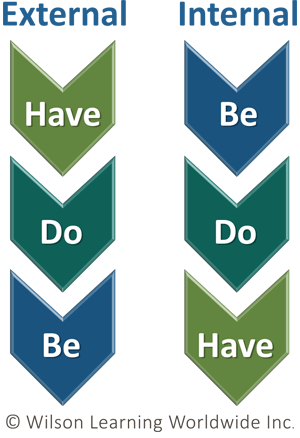Tuning in to Internal Signals
Establishing Strong Leadership Character (Leadership Insights Series)

Leaders today find themselves in a predicament; many are simply too busy to think about what really matters most to them or to take the time to examine what they are doing or why they are doing it. With employee engagement studies indicating a widespread mistrust of leadership, a leader with weak or faulty leadership character can be a huge organizational liability. But, a leader with strong leadership character can be a tremendous asset.
How grounded are leaders in your organization? And how well does your organization prepare mid-level managers to be effective leaders, rooted with a strong leadership character?
As mid-level leaders deal with increased complexity and uncertainty, they are less able to “go by the book” to figure things out. Acting as “corporate translators,” they are essentially placed in the middle of executives and first-level managers. They are responsible for translating corporate strategy, change initiatives, and organizational goals—which they were not involved in developing—into action by engaging others in committing their full energy to creating value and success. This dilemma is compounded by the fact that often they are not clear how committed they are themselves.
These leaders need to engage in honest reflection and self-examination about their leadership beliefs and what they want to BE as a leader, given their widened span of control and greater impact within the organization. To effectively perform at mid-level leadership, leaders need to be well grounded on what it means to BE an effective leader.
Developing Great Leaders
The Wilson Learning approach to assessing and developing leaders was created to tap both the Essence and Form of leadership. Character-based or Essence leadership refers to what is at the core—those qualities of a leader that are driven from the inside out. Essence is about purpose, values, beliefs, and vision; it is who the leader wants to BE to his or her followers. A leader’s identity and the example he or she wants to set is based on his or her Essence.
Form refers to what a leader needs to DO—behaviors and actions a leader takes to demonstrate leadership competencies. These are often driven by organizational rules and policies. Form comes from the outside in. It is the image or persona the leader creates.
While both Essence and Form are essential to effective leadership, they need to be in balance, particularly for mid-level leaders. Often, if there is no integration between Essence and Form, a credibility gap appears and mistrust of leadership becomes an issue. Integrity is the integration between who one is and what one does as a leader—Essence and Form.
Tuning in to Internal Signals
For mid-level leadership, the role of Essence expands. While mid-level leaders now need to acquire one-to-group skills (Form) to facilitate problem-solving, team goal setting, and cross-functional collaboration, the need for character development (Essence) increases significantly.
This Essence transition requires a mid-level leader to build strong leadership character as a Purpose- and Value-Centered Leader. Because mid-level leaders have more experience, there is often a greater readiness for reflection and self-examination of their philosophies, beliefs, and values. And, that Essence transition starts by understanding where leaders get the signals that guide them.
 When we ask managers or leaders, particularly newer ones, what they need to be effective as a leader, they will often start by describing what they think they need to have. They describe the need for power, authority, responsibility, control of the budget, etc. When we ask them what they would do if they had those things, they say they would make decisions, set goals, and guide performance. We then ask if they did those things, what would they be? They usually say they would be successful, promoted, valued, and so forth. Their approach takes the perspective of Have-Do-Be: “I need to have the authority, so I can do more, so I can be successful.”
When we ask managers or leaders, particularly newer ones, what they need to be effective as a leader, they will often start by describing what they think they need to have. They describe the need for power, authority, responsibility, control of the budget, etc. When we ask them what they would do if they had those things, they say they would make decisions, set goals, and guide performance. We then ask if they did those things, what would they be? They usually say they would be successful, promoted, valued, and so forth. Their approach takes the perspective of Have-Do-Be: “I need to have the authority, so I can do more, so I can be successful.”
The Have-Do-Be perspective looks for external signals to guide leadership character, with success being measured by appearance, position, and title. Life is lived on “approval.”
However, mid-level leaders who have already developed Purpose- and Value-Centered Leadership flip the approach to Be-Do-Have: “I need to be a Purpose-Centered Leader, which guides what I do as a leader, and only then will I have the sense of how to contribute to the success of others.” The Be-Do-Have perspective looks for internal signals and responds to values to guide leadership, with success being measured by effectiveness and contribution to others, not title or salary. Life is lived on “purpose,” not on the approval of others. When this is the case, leaders often find what they initially thought they needed to have to be successful—like position, title, power, etc.—wasn’t really so important.
Whether the leader wants to or not, he or she is being watched and is, therefore, always setting an example. Employees look for signals that reveal what the leader stands for and what the leader plans to do. Character-based leadership requires an intentional shift to set an example from the inside out, one that exemplifies what they stand for—their purpose, values, beliefs, and vision. And that takes a large dose of both resiliency and courage.
Over the decades, we’ve asked employees what they want to see from leadership. Many have said trust, integrity, and being the example, in addition to courage. When asked what they meant by courage, employees implied it wasn’t the courage of taking risks but the courage of “being”—of standing for something.
In challenging times, people are looking for some kind of constancy in their life. It is often difficult to find this in their work, with their customers or marketplace, or in the ever-changing business environment.
Leaders can be a source of constancy for other people, but not if they get their leadership signals from external sources that are always subject to change. Leadership actions based on external signals suggest that a leader must win people’s approval to get them to follow. But the reality is that people tend to follow leaders who are true to what they believe in and act consistently on their beliefs, even when their actions may not be popular. These are the resilient, courageous leaders. And that is why focusing on internal signals is so important. Essence-based leadership is about having an internal compass that drives your example and fortifies a strong leadership character—for other leaders, employees, the organization, and customers.
To learn more, contact Wilson Learning at 1.800.328.7937 or complete the online form.







 Please complete this form to download Tuning in to Internal Signals | Establishing Strong Leadership Character (Leadership Insights Series).
Please complete this form to download Tuning in to Internal Signals | Establishing Strong Leadership Character (Leadership Insights Series).



